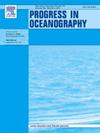海山在少营养的开放海洋中造成了全氟烷基和多氟烷基物质的局部热点
IF 3.6
3区 地球科学
Q1 OCEANOGRAPHY
引用次数: 0
摘要
全氟烷基和多氟烷基物质作为一种持久性有机污染物广泛存在于海洋中。海山广泛分布于全球深海,是海洋生物多样性和各种渔业资源的热点,可以极大地改变洋流方向,从而调节污染物的分布。然而,它们对PFAS分布的影响尚不清楚。本研究首次对西北太平洋麦哲伦海山链蔡尾、魏家和Fedorov海山的PFAS分布进行了全面的深度剖面调查。本文报道了深海海山海水中15种靶向PFAS。研究结果表明:(1)海山峰顶1000 m以下水柱中PFAS的平均深度积分浓度为112.0±78.4 pg/L,是周边盆地参考站的1.4倍;(2)海山中上层带是PFAS分布的热点,富集明显,“PFAS海山效应”明显;(3)替代PFAS所占比例高于遗留PFAS,且在中上层存在明显富集,表明替代PFAS是该地区主要的PFAS污染物。这项研究强调了加强污染物基线监测的重要性,特别是替代PFAS浓度,在海底山保护战略的保护工作中。本文章由计算机程序翻译,如有差异,请以英文原文为准。

Seamounts create local hotspots of per- and polyfluoroalkyl substances in the oligotrophic open ocean
As one persistent organic pollutant, per- and polyfluoroalkyl substances (PFAS) are widely present in oceans. Seamounts, widely distributed in the global deep sea, are hotspots for marine biodiversity and a wide range of fishery resources, can dramatically alter ocean currents direction and then regulate the distribution of pollutants. However, their impact on PFAS distribution is still unknown. This study conducted the first comprehensive depth-profile investigation of PFAS distribution in the Caiwei, Weijia, and Fedorov seamounts along the Magellan Seamount Chain in the Northwestern Pacific. Here, we report 15 targeted PFAS in seawater of the deep-sea seamount. The main findings of the study are as follows: (1) the average depth-integrated concentration of PFAS in the water column shallower than 1000 m at seamount summits were 112.0 ± 78.4 pg/L, which were 1.4 times higher than those at the surrounding basin reference stations; (2) the mesopelagic zone of seamounts is a hotspot for PFAS distribution, characterized by obvious enrichment, highlighting a distinct “PFAS seamount effect”; (3) alternative PFAS account for a higher proportion than legacy PFAS and exists obvious enrichment in the mesopelagic zone, indicating that alternative PFAS are the dominated PFAS pollutants in this region. This study highlights the importance of enhanced baseline monitoring of pollutants, particularly alternative PFAS concentrations, in conservation efforts for seamount protection strategies.
求助全文
通过发布文献求助,成功后即可免费获取论文全文。
去求助
来源期刊

Progress in Oceanography
地学-海洋学
CiteScore
7.20
自引率
4.90%
发文量
138
审稿时长
3 months
期刊介绍:
Progress in Oceanography publishes the longer, more comprehensive papers that most oceanographers feel are necessary, on occasion, to do justice to their work. Contributions are generally either a review of an aspect of oceanography or a treatise on an expanding oceanographic subject. The articles cover the entire spectrum of disciplines within the science of oceanography. Occasionally volumes are devoted to collections of papers and conference proceedings of exceptional interest. Essential reading for all oceanographers.
 求助内容:
求助内容: 应助结果提醒方式:
应助结果提醒方式:


